Over the years many incredibly powerful, or simply incredibly weird, Magic: the Gathering cards have been printed.
To keep these cards from breaking the game and keeping it as one of the best trading card games in the world, they have been taken aside and banned, usually for an array of reasons.
Here are the best stories of gamebreaking cards, and why these banned MTG cards were removed by the creators.
Table of Contents
Toggle10. Chaos Orb and Falling Star
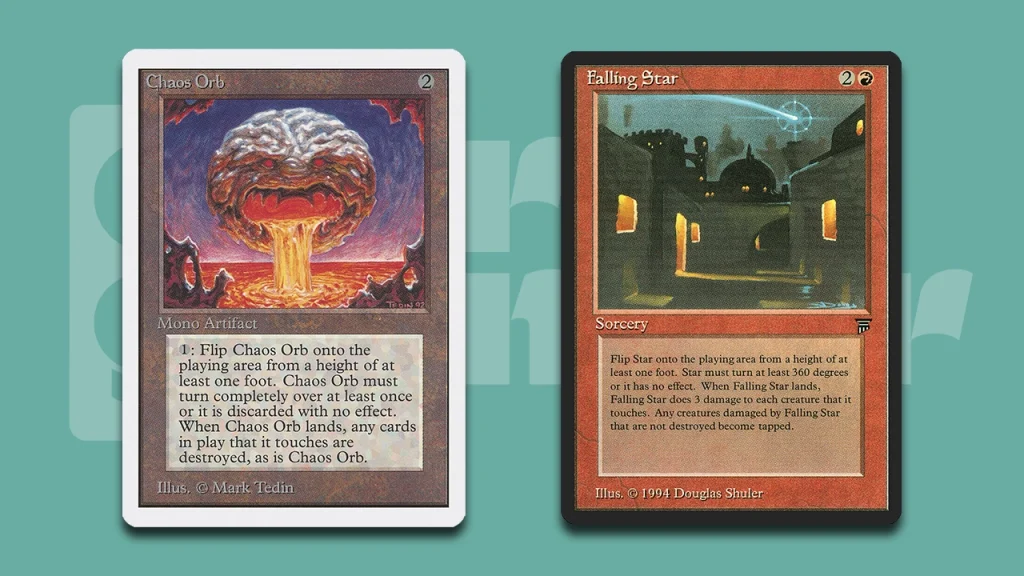
Chaos Orb and Falling Star are both banned in every MTG format, but not because of their strength. These cards need to be flipped into play from a height of at least one foot.
If they manage to turn over completely in the air before landing, then they provide an impactful effect. Falling Star deals three damage and taps every creature card that it touches, while Chaos Orb destroys any non-token permeants it comes into contact with.
Chaos Orb is notorious thanks to a popular, but fictitious, urban legend of a player tearing it into tiny scraps, and then throwing these pieces at their opponent’s cards, thus destroying them all.
Even if Chaos Orb weren’t banned attempting this in a tournament would result in immediate disqualification.
You would be modifying your deck list and removing a card in the middle of a match, and physically tearing up a card probably counts as “marking” it which is not permitted. The legend of the shredded Chaos Orb is referenced by the Unglued joke card Chaos Confetti.
The real reason these cards are banned has nothing to do with the famous story. Instead, both of these cards are illegal because they require fine motor skills. This puts players with poor manual dexterity, or those who may be unable to flip them due to a physical impairment, at a disadvantage as a result, these cards are banned.
9. Ante Cards
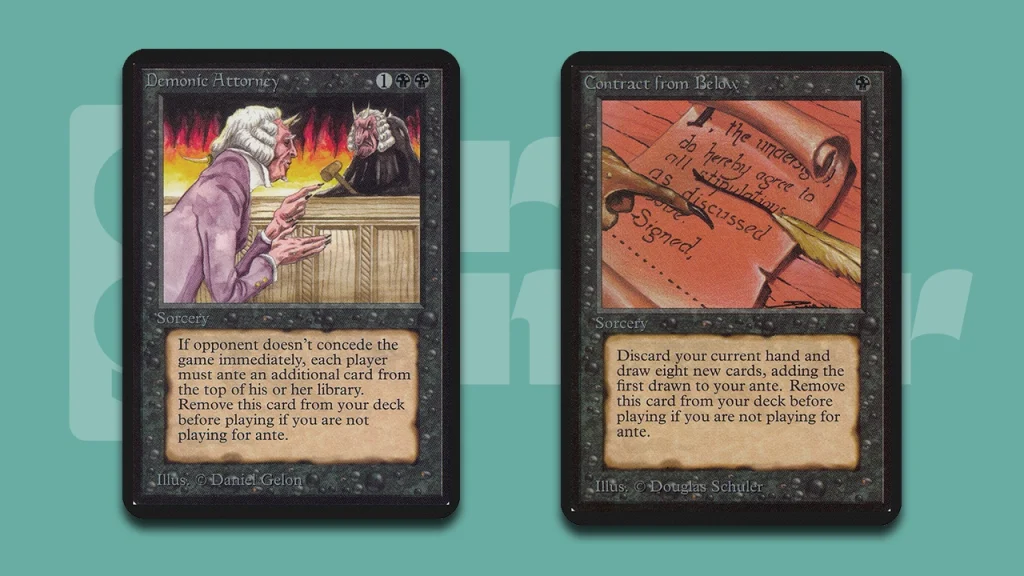
When Magic: the Gathering began, the Ante rule added some spicy risk to games. At the start of gameplay, each player would ante the top card of their deck, putting it in a separate zone outside of play.
At the end of the game, the winning player would take all of the cards in the ante zone as a prize.
There are 9 Ante cards. Demonic Attorney, is a notable example. It adds another card from the top of each players deck to the ante unless the opponent surrenders immediately.
Contract From Below, is a powerful one mana Black spell that allows its controller to discard their hand and draw eight cards, putting the first of these cards into the ante.
Ultimately Anteing was cut from the game. Keeping the Ante rule may have resulted in MTG getting classified as gambling. This would require tournament venues to obtain a gambling license.
In addition, it would prevent players younger than 18 from playing competitively.
8. Shahrazad
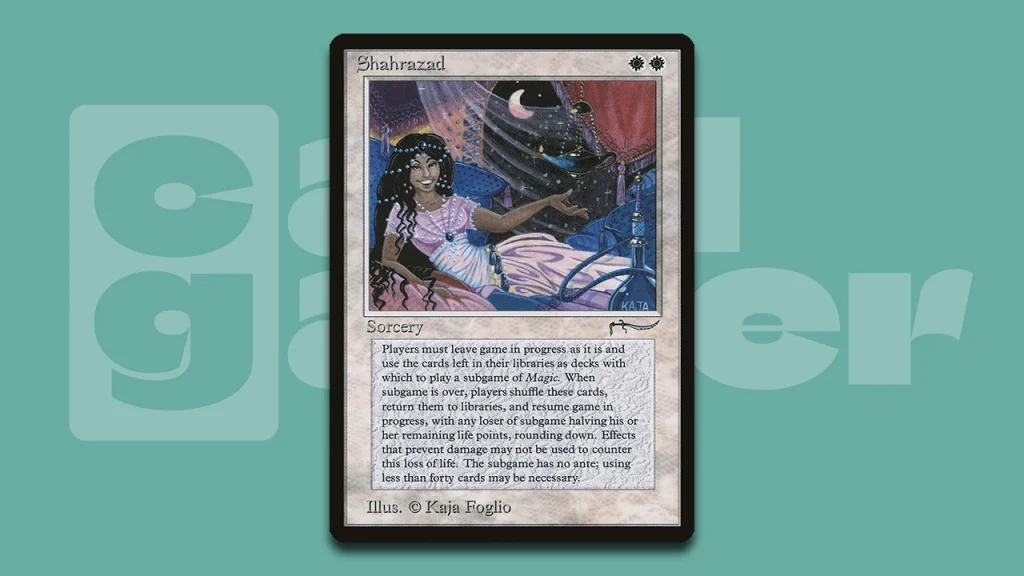
Shahrazad is one of the most unique cards in the history of Magic: The Gathering, and is an example of a wonderfully flavorful design going horribly wrong in practice.
Released in December of 1993 in Arabian Nights, the first ever MTG expansion, Shahrazad is a two White mana sorcery. When Shahrazad is played, players take their decks and start playing a subgame. The loser of that subgame loses half of their life once the main game resumes.
This card cleverly references the Tales of the 1001 Arabian Nights. Shahrazad, the story’s protagonist, marries a cruel king who executes his wives after spending the night with them.
Shahrazad manages to save her life by distracting the king with stories, just like the card distracts opponents with subgames.
Shahrazad demonstrates how simply being evocative can’t save a card that has a horrible effect. Shahrazad has the potential to double the length of any game.
What’s worse, if a player is running multiple copies of Shaharazd then subgames can be started within subgames, creating Inception-esque layers of games within games. The card is banned in every single Magic: the Gathering format for obvious reasons.
7. Inverter of Truth
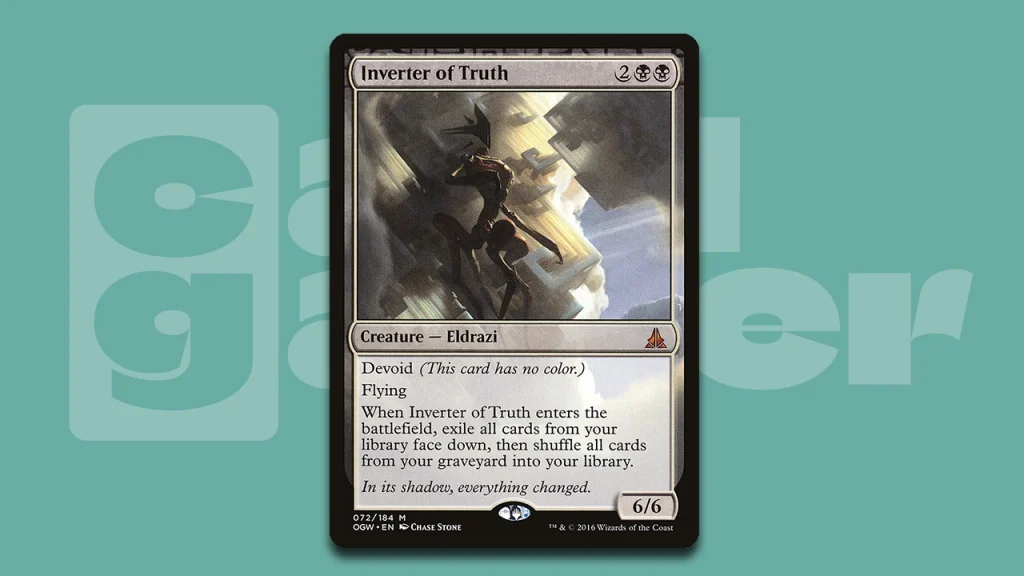
Inverter of Truth was released in 2016, it spent four years gathering dust before dominating the early days of the Pioneer format
For two mana of any color and two Black, Inverter of Truth is a 6/6 flyer that exiles its controller’s library when it enters play. The owner of Inverter of Truth then shuffles their graveyard which becomes their new library. Although four mana for a 6/6 flyer is great, Inverter of Truth’s library exiling effect kept players from experimenting with it.
This all changed with the release of Theros Beyond Death in January 2020, which included the card Thassa’s Oracle.
An infamous card in its own right, Thassa’s Oracle has closed out countless games of CEDH. Thassa’s Oracle costs two Blue and allows its controller to look at the top X cards of their library where X is their Devotion to Blue (in other words, the number of Blue pips in the mana cost of cards they control).
If a player’s devotion to Blue is greater than the number of cards remaining in their library, Thassa’s Oracle wins them the game.
The plan of Dimir Inverter decks was to protect themselves in the early game using cheap control cards like Fatal Push and Thoughtseize. Dig Through Time could then clear out the Graveyard, whilst searching for the Inverter and the Oracle. Once these cards were found, Inverter of Truth would come down and exile its controller’s library, followed by Thassa’s Oracle ending the game.
Inverter of Truth was banned in Pioneer on the 3rd of August 2020. Thassa’s Oracle remains free, waiting for a new card to abuse its huge potential.
6. Felidar Guardian
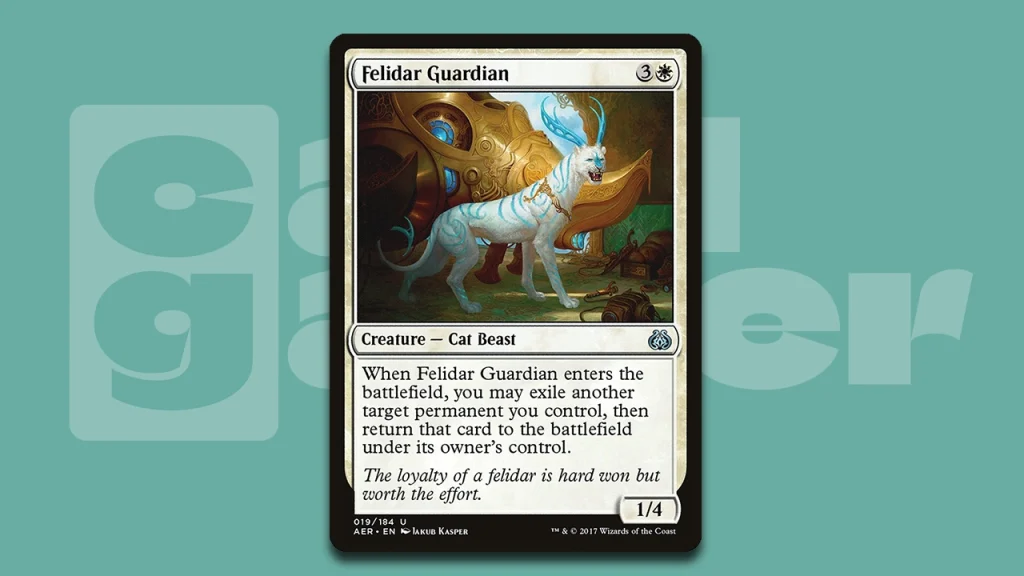
Felidar Guardian is probably one of the weakest cards to be banned in multiple formats. This cat was banned from Standard on the 26th of April 2017 and Pioneer on the 4th of November 2019. Felidar Guardian is a 4 mana 1/4 which flickers another permanent when it enters the battlefield.
This little Felidar doesn’t seem powerful enough to get booted out of two formats, however, it happens to create an infinite combo when used alongside the Planeswalker Saheeli Rai.
Here’s how the combo works:
- Step 1: Have both Saheeli and the felidar in play simultaneously.
- Step 2: Use Saheeli’s -2 ability to create a token copy of Felidar Guardian with Haste.
- Step 3: When the token copy enters play, flicker Saheeli with it.
- Step 4: Saheeli will return to play with her loyalty counters refreshed and able to use one of her abilities again.
- Step 5: Repeat steps 2-4 in order to create a theoretically infinite number of hasty 1/4 Felidar Guardian tokens.
- Step 6: Crush the competition with a cataclysmic cavalcade of cats.
The power of this combo, made it clear that either Felidar Guardian or Saheeli Rai needed to be banned. Given that Saheeli’s card marks the debut of an iconic Planeswalker, whilst Felidar Guardian is just a random flickering feline, the choice was clear. The poor little Cat Beast was even excluded from Kaladesh Remastered on MTG Arena because of these shenanigans.
5. Skullclamp
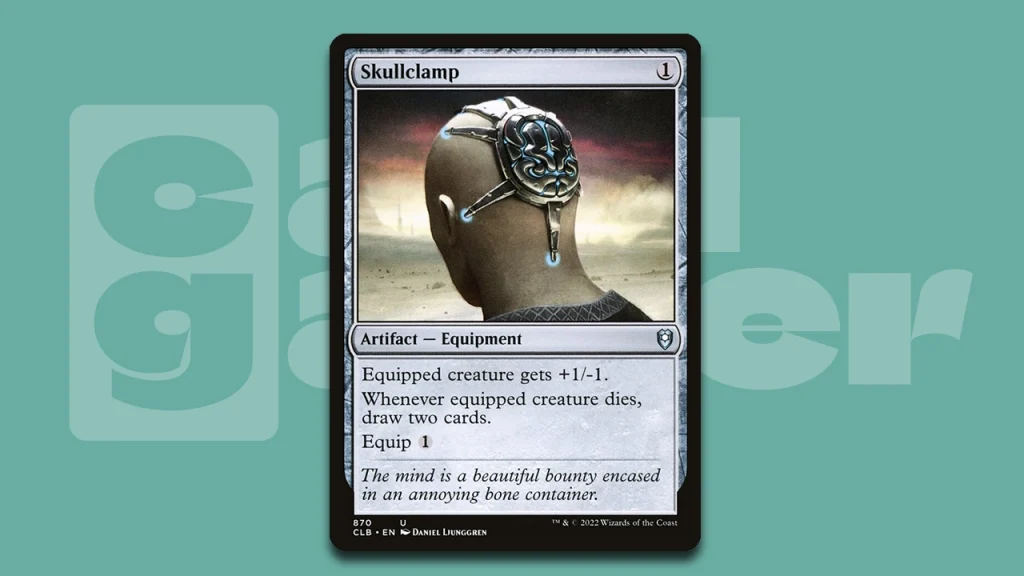
Skullclamp is the story of a change transforming a card from completely forgettable to hugely overpowered.
Aaron Forsythe, a Senior Magic designer, has described, the design process that led to Skullclamp becoming, arguably, the most infamous piece of equipment in the game.
Initially, Skullclamp was a three mana piece of equipment that cost two to equip and drew its controller two cards when the equipped creature died.
The card was perceived as unremarkable, so it was buffed to provide a +1/+2 bonus. This version was also too weak, so it was altered to cost only a single point of mana, and its equip cost was dropped down to one. Alongside this, the stat modification it provided was changed from +1/+2 to +1/-1.
While the -1 reduction to toughness may seem like a downside, it is actually a significant benefit. Sacrificing a 1/1 creature to draw two cards is fantastic, especially at the cheap rate that Skullclamp offers.
Skullclamp’s ability to do this repeatedly pushes its strength over the edge. Players can use Skullclamp to churn through their decks, drawing cards very quickly. The card was banned from Standard in June of 2004, followed by a ban in Extended (the format which evolved into Modern) and Legacy three months later in September.
4. Splinter Twin
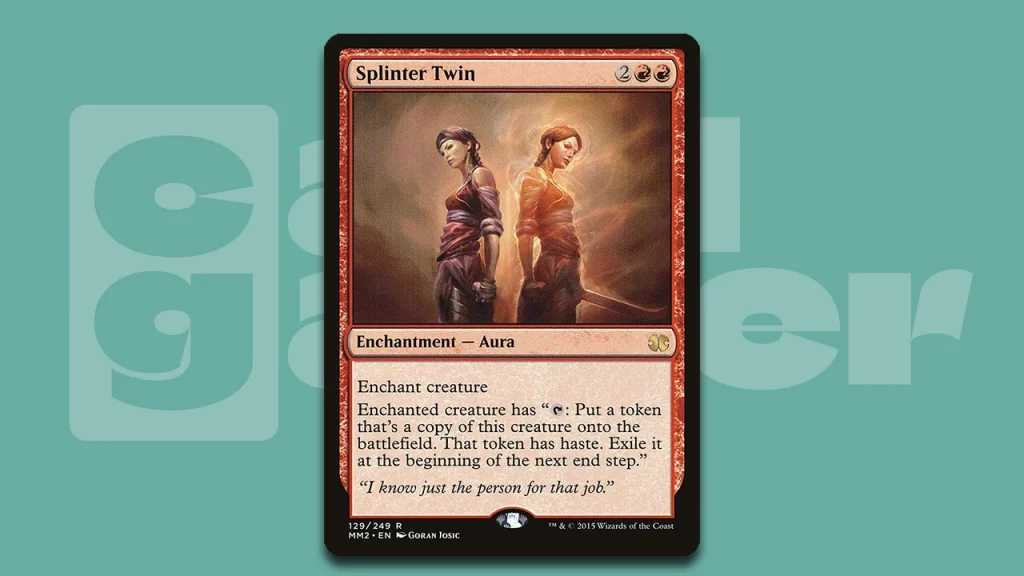
“Unban Splinter Twin!” has been the cry of Modern players for years, but why was it banned in the first place?
Splinter Twin can generate an infinite number of creatures when combined with either Pestermite or Deceiver Exarch.
The card Splinter Twin is attached to can clone itself. When a cloned Pestermite or Deceiver Exarch enters play, it can untap the original creature, which can then be used to generate another clone, causing an infinite loop. This army of clones can then attack for game.
Splinter Twin was banned from Modern in January of 2016. Seven years later, many players are now clamoring for Splinter Twin’s return. The argument is that in a world full of Ragavans and Murktide Regents, a few infinitely cloning Faeries and Phyrexians really aren’t so bad.
3. Jace, the Mind Sculptor
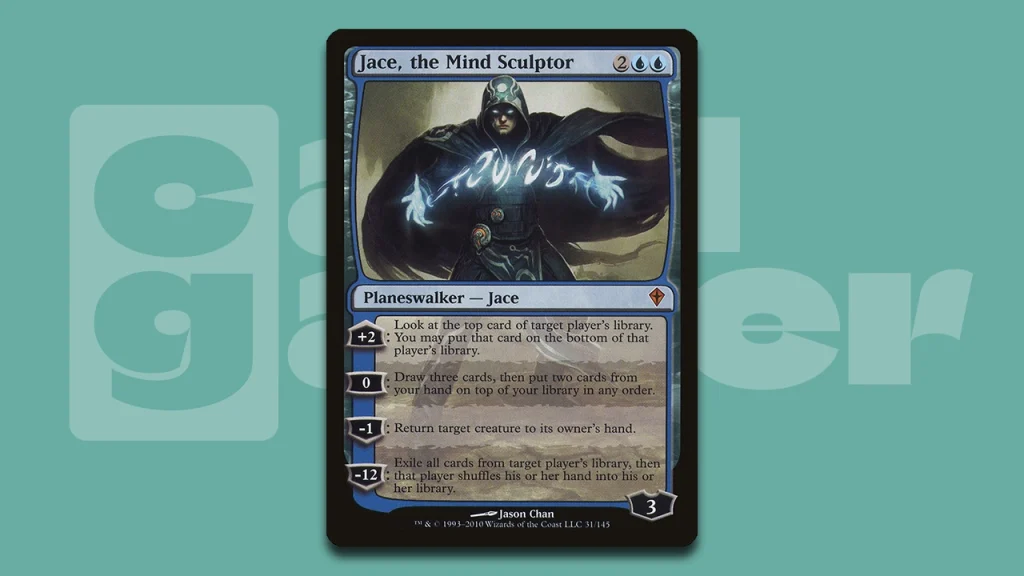
Jace, the Mind Sculptor is one of the most infamous Planeswalkers in the game. This card comes with a suite of powerful abilities. Jace’s +2 effect allows his controller to look at the top card of any player’s library and then put it on either the top or the bottom.
Jace’s 0 loyalty ability provides the effect of the iconic draw spell Brainstorm, whilst his -1 ability bounces a creature to its controller’s hand. The -12 of Jace the Mind Sculptor, like many Planeswalker ultimates, functionally wins its controller the game if its high loyalty cost can be paid.
While each of Jace’s abilities may seem small, together they form a potent combination that can lock opponents out of the game.
Jace’s +2 ensures the opponent will continue to have dead draws, as it plunges any threats they might get down to the bottom of their deck. Jace’s -1 ability ensures that the opponent’s creatures can be returned to their hand, ready to be countered on a future turn.
Finally, Jace’s 0 loyalty ability provides a steady stream of card advantage that keeps his controller in the game.
Jace was banned in Standard in June of 2011 and from the Modern format from the moment of its creation in August of 2011. Eventually, Jace was unbanned from Modern in January of 2018 as the power of the format caught up with him.
Even though he has been unbanned, Jace, the Mind Sculptor is still remembered as one of the most formidable Planeswalkers of all time. Possibly the second strongest…
2. Oko, Thief of Crowns
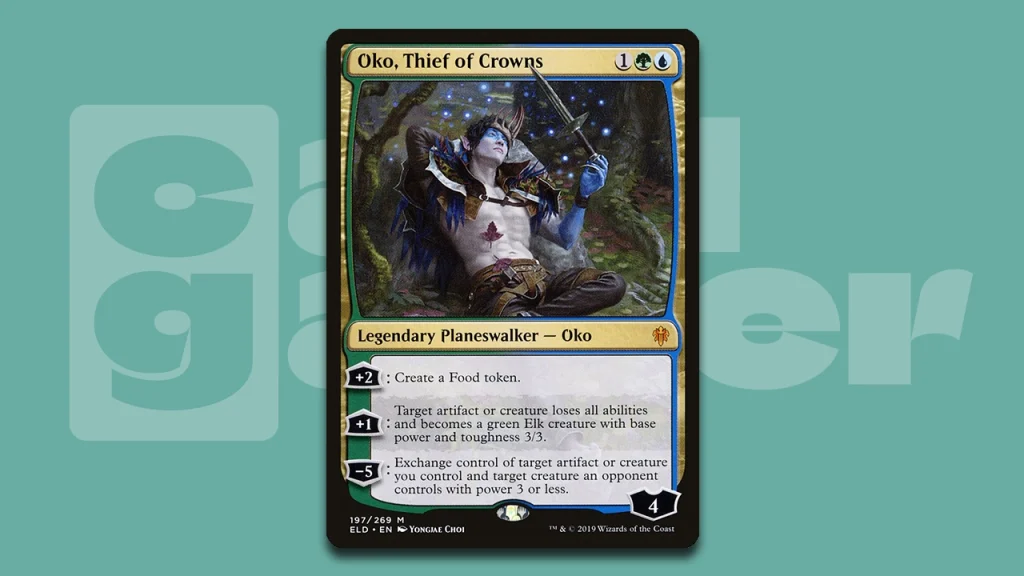
Oko, Thief of Crowns stole Jace’s throne as Magic: the Gathering’s most feared Planeswalker. For only three mana, in Simic colors, Oko is extremely cheap and extremely powerful.
Oko was released in Throne of Eldraine in October of 2019. Oko was banned in Standard in November of 2019, over the next two years, he got banned from Pioneer, Modern, and Legacy.
Oko enters play with four loyalty. His +2 ability generates a food token, his +1 ability turns any artifact or creature into a 3/3 Elk, and his -5 exchanges ownership of one of his controller’s artifacts or creatures with one of their opponent’s.
Oko accumulates loyalty incredibly quickly, making him very difficult to remove. A three mana card should not be able to get up to six loyalty in a single turn, and Magic’s designers have gone on the record to say that Oko’s strength is a mistake.
Since Oko’s ultimate costs only five loyalty, it is very easy to use. The player can create a food token, for themselves and then swap it for a relevant card controlled by their opponent. Oko’s +1 ability can be used offensively, to turn something useless (perhaps a food token) into a 3/3 or defensively to blank an opponent’s big threat.
Oko is an absurdly powerful card that somehow flew beneath the radar of Magic’s designers.
1. Lurrus of the Dream-Den
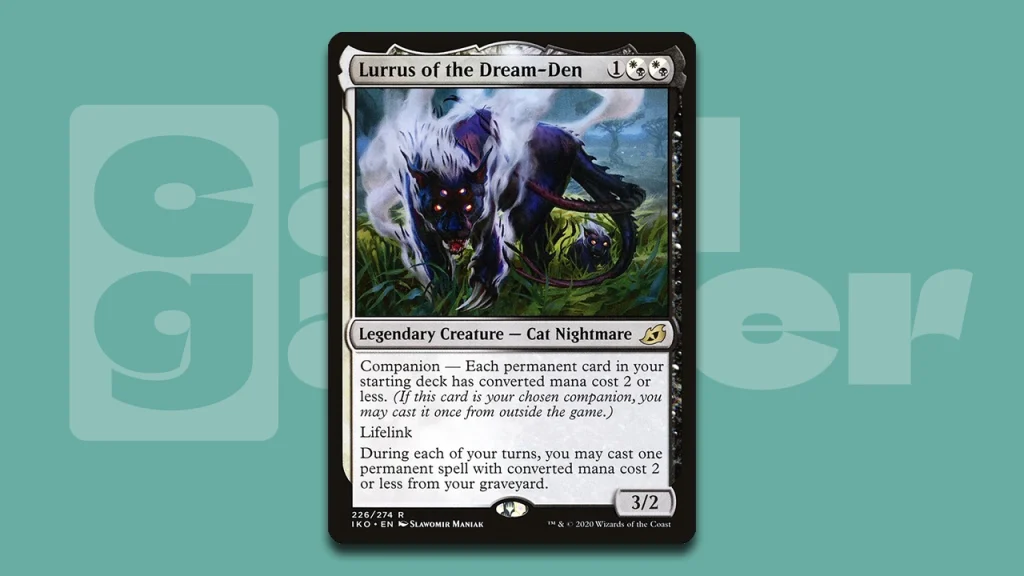
Lurrus of the Dream-Den is the strongest card with the infamously strong “Companion” mechanic. In an attempt to make regular gameplay more like Commander, Companions could (initially at least) be cast from outside the game. In return, Companions impose restrictions on decks featuring them.
For example, Obosh, the Prey Piercer can only be used as the companion of decks that exclusively feature spells with odd-numbered mana costs, and Yorion, Sky Nomad can only be used as the companion for decks featuring 20 more cards than the minimum for their format.
Companion was so powerful that the entire mechanic had to be made weaker retroactively, something unprecedented in Magic’s history.
Rather than being played from outside the game, players now need to pay three mana to add their companion to their hand before they can play it. This change means that the Ikoria printings of the Companions have inaccurate rules text.
Lurrus is the best Companion in the game. Prior to the rules change, the card was banned in the Vintage format, a feat unequaled even by the Power Nine. This ban was reversed after the Companion mechanic was nerfed, but Lurrus is still banned in Modern, Pioneer, Explorer, and Legacy.
The restriction that Lurrus imposes on players is that their deck cannot contain any permanents with a mana value higher than two. Lurrus is a 3/2 lifelinker for three mana. Lurrus allows its controller to cast one permanent with mana value two or less from their graveyard each turn.
This ability is stronger in higher-powered formats with large numbers of very powerful cards with low costs.




